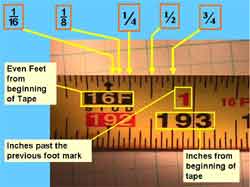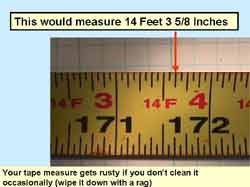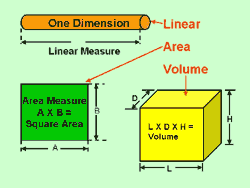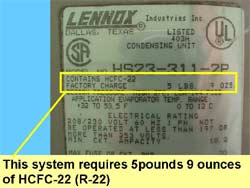HVACR Fundamentals 101
101-1: Measurements are
Important
Page 3
Linear measurement — The distance from point A to point B. The shortest distance between two points is a straight line or a linear distance. A tape measure is the most common tool a technician uses for linear measurement. It is convenient and necessary to every project.

You need to be able to read a tape measure to the smallest increment reasonable for the job. A technician must know the tolerances required, whether they are plus-or-minus 1 inch, 1⁄4 inch or less. Therefore, a technician must know what the scale on a tape represents. See the detail below.
 |
 |
Click to enlarge |
Click to enlarge |
There are three common types of results sought with linear measurements (shown here). They are length (example: how much pipe, in feet and inches or meters and centimeters, is needed to reach from a boiler to a radiator); area (example: how many square feet in a room is a factor in a heat load calculation); and volume (example: how much fuel will fit into a storage tank).
 |
Click to enlarge |
Mass:
The mass of an object is a measure of the quantity of matter that a body or object contains. Mass is significant in measuring momentum, or how much energy it takes to start an object moving or to change its speed or direction once it is moving.
Do not confuse mass with weight. Although the two terms are often used interchangeably, they are not the same. Weight is a measure of the force or attraction of gravity on an object. The weight of an object changes as the
gravitational force on the object changes. The mass of an object does not
depend on gravity, so it never changes.
For example: A person with a mass of 80 kilograms (kg) weighs 176 pounds on earth. On the moon, the person still has a mass of 80 kg but weighs only 29 pounds (or 13.3 kg).
Our familiar basic weight measurement (from the U.S. Customary system) is the pound (lb.), divided into 16 equal measures called ounces (oz.). 2000 pounds equals one ton. A note of caution: if you are measuring a large object its weight may be expressed in tons, but don’t confuse this weight-related ton with refrigeration effect ton.
In the metric system (or System International — SI), used widely in the rest of the world, a basic unit is the kilogram. A kilogram (kg) is divided into 1000 equal parts called grams (g). Kilo signifies a multiplier of 1000 — a kilometer is 1000 meters. A quick tour of one of the online conversion sites listed in "References" (101-2 web links) shows that 1 kilogram is equivalent to 2.2 pounds and 1 pound = .4536 kilograms. Conversions go both ways.
 Applications of weight measurements are as varied as the jobs HVACR technicians are involved in. A common weight calculation is how much refrigerant is to be charged into a system. The data
plate on a unit specifies a weight in pounds and/or ounces. If a data plate specifies 200 oz. of refrigerant charge, and you are using an electronic scale that reads in pounds, it is necessary to convert ounces to pounds and ounces. 200 oz. ÷ 16 oz./lb. = 12.5 lbs, or 12 lb., 8 oz. of refrigerant charge.
Applications of weight measurements are as varied as the jobs HVACR technicians are involved in. A common weight calculation is how much refrigerant is to be charged into a system. The data
plate on a unit specifies a weight in pounds and/or ounces. If a data plate specifies 200 oz. of refrigerant charge, and you are using an electronic scale that reads in pounds, it is necessary to convert ounces to pounds and ounces. 200 oz. ÷ 16 oz./lb. = 12.5 lbs, or 12 lb., 8 oz. of refrigerant charge. Copyright © Blue C LLC. All rights reserved.